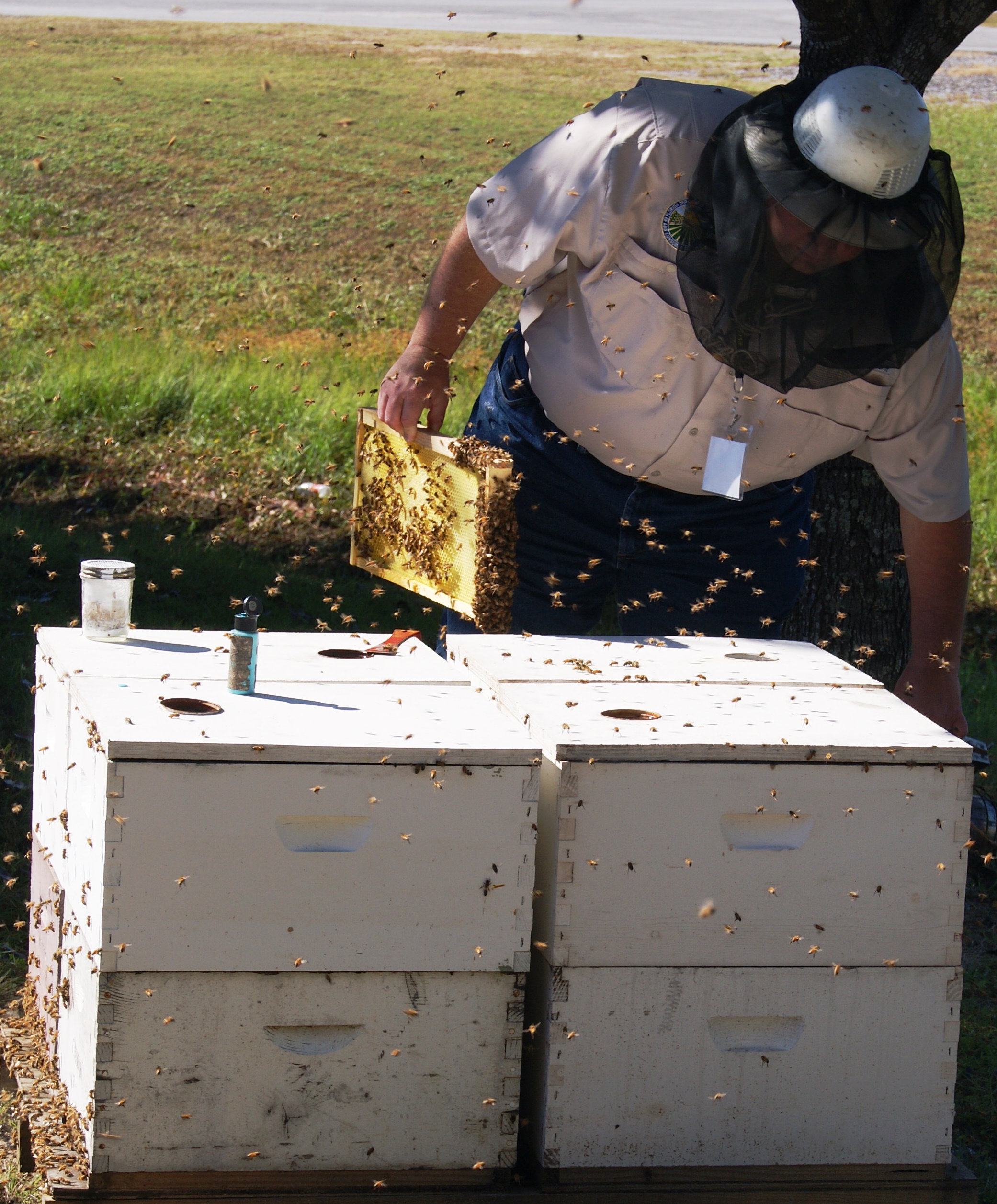
by Judy Biss | Feb 7, 2014
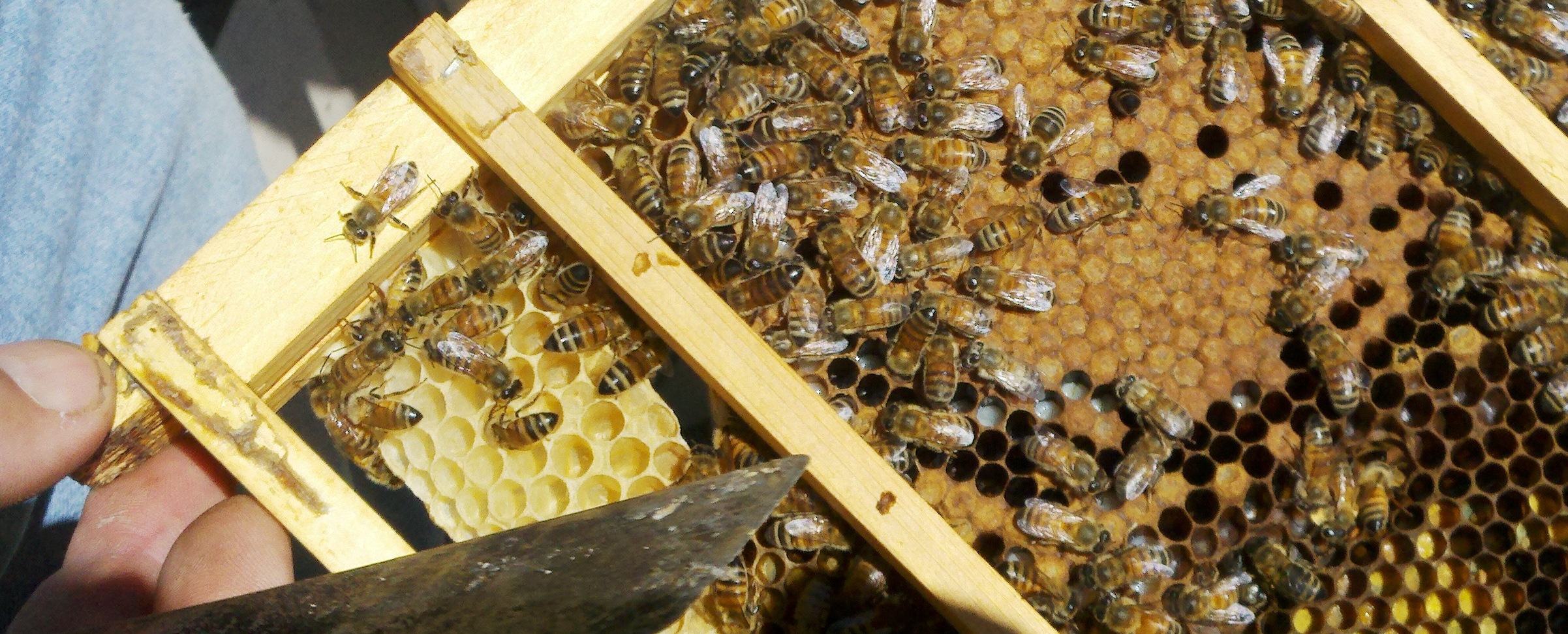
Photo by Judy Ludlow
The UF/IFAS Panhandle Agriculture Extension Team will once again be offering a Basic Beekeeping School in February and March. These classes will be offered via interactive video conferencing at Extension Offices across the Panhandle. Details are listed below, please call your local UF/IFAS Extension Service to register and if you have any questions. See you there!
- These classes will be taught by Dr. Jamie Ellis and other state and nationally recognized beekeeping experts from the University of Florida Honey Bee Research and Extension Lab and the Florida Department of Agriculture & Consumer Services Bureau of Plant and Apiary Inspection.
- There will be three Monday-evening and one Tuesday evening interactive video conferences from 6:00 – 8:00 pm Central time, (7-9 pm Eastern time) and a Saturday bee-yard field day.
- Each 30-50 minute presentation will be followed by a question/answer period
February 24: Honey Bee Biology and Anatomy
March 3: Varroa Mite Biology and Control
March 10: Honey Bees of the World and Beekeeping History
March 15: Bee-Yard Field-Day – A hands on teaching opportunity
March 18: Yearly Management of the honey bee
- The cost for all five classes is $25 per person or $40 for a family. This fee will cover course materials and refreshments.
- Deadline to register is February 17, 2014. Please contact your local UF IFAS Extension office to register or to find out more details, or click on the following link for a printer-friendly flyer: 2014 Beekeeping in Panhandle
Bay County 850-784-6105
Calhoun County 850-674-8323
Escambia County 850-475-5230
Franklin County 850-653-9337
Gadsden County 850-875-7255
Gulf County 850-639-3200
Holmes County 850-547-1108
Jackson County 850-482-9620
Jefferson County 850-342-0187
Leon County 850-606-5202
Liberty County 850-643-2229
Okaloosa County 850-689-5850
Santa Rosa County 850-623-3868
Wakulla County 850-926-3931
Walton County 850-892-8172
Washington County 850-638-6180
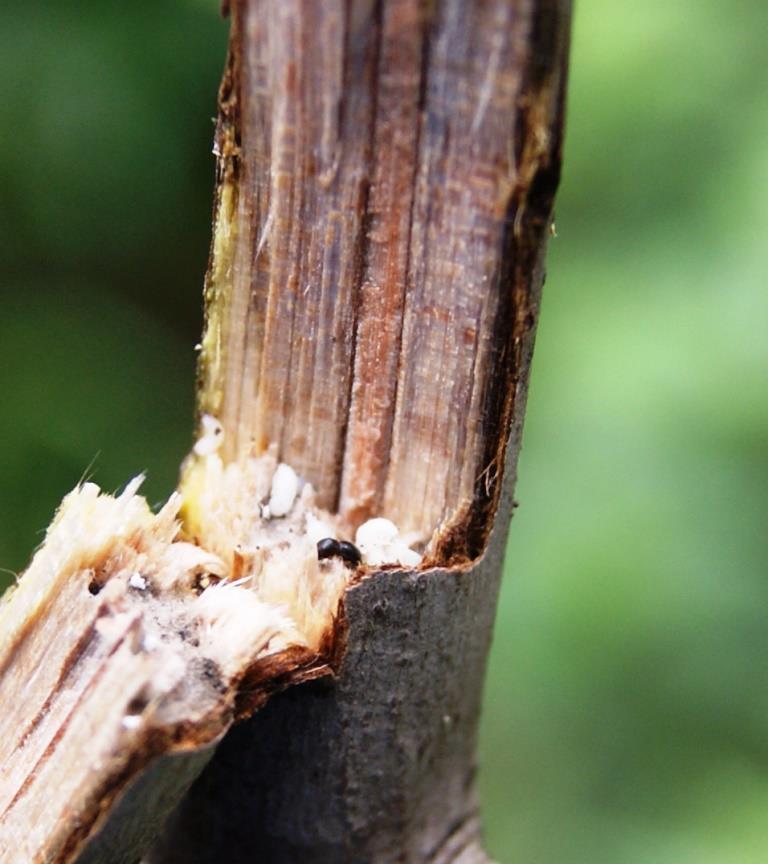
by Larry Williams | Dec 17, 2013
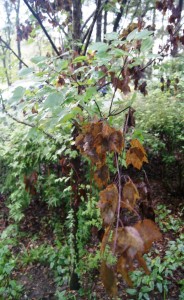
Common symptoms of the black twig borer. Image Credit Matthew Orwat UF IFAS Extension
Q. Small branches are dying in some of my trees. What’s causing this?
A. More than likely the culprit is the Black Twig Borer. This very small beetle, about 1/16 inch long, has been active this year.
Common trees attacked include cedar, golden rain tree, maple, redbud, sweetgum, loquat, dogwood, Shumard oak, Chinese elm, magnolia, Bradford pear and pecan. The beetle is not limited to these trees. And it may attack woody shrubs and grapevines.
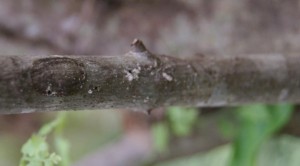
Black Twig Borer Entry Holes. Image Credit Matthew Orwat UF IFAS Extension
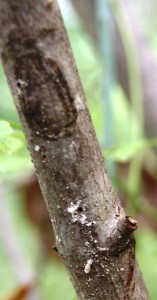
Black Twig Borer Entry Holes. White Frass Visible. Image Credit Matthew Orwat UF IFAS Extension
This beetle only damages branches that are approximately pencil size in diameter. These small branches die above the point of entrance with the leaves turning brown, creating a flagging effect of numerous dead branches scattered throughout the outer canopy of the tree. These dead twigs with their brown leaves are what bring attention to the infested trees.
Bending an infested twig downward will result in it snapping or breaking at the entrance/exit hole. Carefully putting the twig back together may allow you to see the hole. The hole is usually on the underside of the branch and will be very small, about the size of pencil lead in diameter. Sometimes you may see the minute, shiny black beetle and/or the white brood inside the hollowed out area of the twig at the point where it snapped.
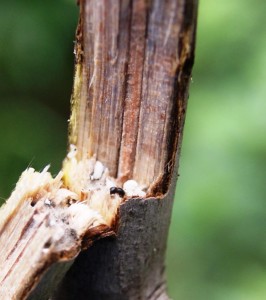
Black Twig Borer inside the stem. Image Credit Matthew Orwat UF IFAS Extension
The black twig borer, Xylosandrus compactus, is one of the few ambrosia beetles that will attack healthy trees. However, the heavy rainfall this summer stressed many of our tree and plant species making them more susceptible to insect damage and disease.Female beetles bore into small branches or twigs of woody plants, excavate tunnels in the wood or pith and produce a brood. Damage occurs when the beetle introduces ambrosia fungi on which the larvae feed. The beetles emerge in late February, attack twigs in March and brood production begins in April. Highest population levels occur from June to September. Adults spend the winter in damaged twigs and branches. So it’s important to pickup and dispose of the small branches as they fall.
Where practical, the best control is to prune tree limbs 3-4 inches below the infested area, then remove and destroy the limbs. Proper mulching, avoiding over fertilization and irrigating during dry weather should improve tree health, allowing trees to better withstand attacks. Chemical controls are usually not practical or effective.
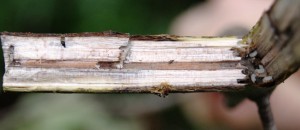
Entry point from a different angle. Image Credit Matthew Orwat UF IFAS Extension
Additional information on this beetle is available though the UF IFAS Extension Office, your County Forester or online at the UF IFAS Featured Creature page
by Alex Bolques | Nov 25, 2013
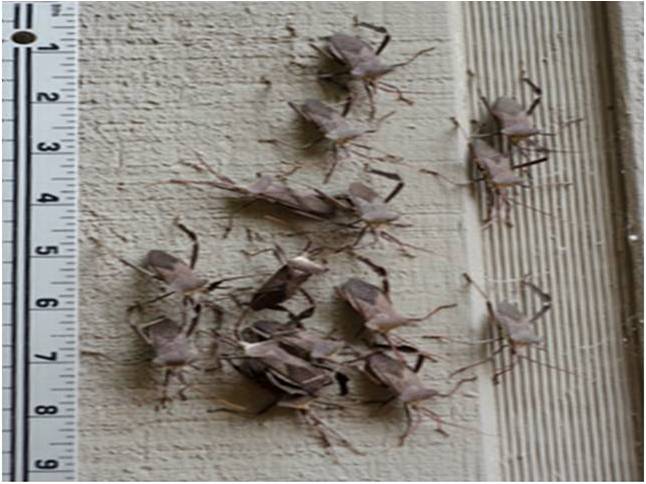
In search of an entry point into a home: Leaf footed bugs congregating on house siding in search of a warm sheltered environment to spend winter. Courtesy of Bill Stinson
Leaf footed bugs are pests of many seed, fruit, vegetable and nut crops. They get their name from the leaf shape of their back legs. The insect is dark brown to black and about an inch long. Like ladybird beetles, leaf footed bugs can invade your home in the fall in search of a warm sheltered environment to spend winter. In some cases, this may be inside your home. However, unlike ladybird beetles, which can invade a home by the hundreds, leaf footed bugs numbers are considerably less.
In both cases, they enter the home through openings such as cracks, crevices, crawl spaces, attics, ridge vents etc. Once inside, they do not cause any damage, eat, drink or reproduce. Instead, they go into what is called diapause, a dormant state. If you encounter them in living spaces of the home, a common management practice is to collect them by hand or mechanically by removing them with a vacuum cleaner and then releasing them outside. Leaf footed bugs are related to stink bugs and will give off an odor if crushed or held to long in your hand. Once spring arrives, they will become active and you may find them roaming around living spaces again. Use the same control tactic to help them find their way to the outside of the home.
It should be noted that ladybird beetles are considered a beneficial insect that feeds on crop-damaging insects such as aphids, mealy bugs, and white flies. On the other hand, leaf footed bugs are a serious pest of cotton and a direct pest of many seed, fruit, vegetable and nut crops.
Reference
Stink Bugs and Leaf-footed Bugs Are Important Fruit, Nut, Seed and Vegetable Pest
by Mary Salinas | Nov 4, 2013
For centuries, people annoyed with plant pests have used oils to control insects, mites, and even some fungal diseases. Current oil products are better than ever!
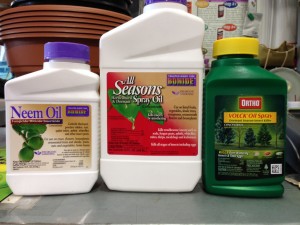
Sample oil products for pest control. Photo by Mary Derrick.
Commercially available horticultural oils are mineral oils from refined petroleum products. Impurities are removed and then an emulsifying agent is added that allows the oil to mix with water for application. Neem oil is a newer product that has become increasingly popular; the oil is an extract of the seeds of the neem tree.
What are some of the advantages of using an oil for pest control?
- Oils are inexpensive and easy to apply
- Oils can be used on most plants (check the label for a list!)
- Oils control a wide range of pests that feed on plants (again, check the label for a list of pests the product will control!)
- Oils pose a low risk to people, pets, and desirable beneficial predators
- Since oils kill pests by blocking their breathing holes (spiracles) and/or gumming up their mouthparts, there is no chance for resistance to develop
- One product can control both insects and some diseases like powdery mildew at once
- Oils can be combined with some other pesticides to provide greater control
[warning] Don’t combine with, or use within 30 days of, any sulfur based pesticide. The combination can harm your plants![/warning]
There are always drawbacks to a product. What are the drawbacks?
- Some plants (including cryptomeria, junipers, cedars, maples, and redbud) are damaged by oils – check the label!
- Ensure good coverage during spraying as pests must be contacted with the oil in order for the control to work
- Oils break down quickly and reapplication may be necessary
- Check the label for instructions on the temperature range when it can be used. Older formulations generally are safe when temperatures are in the 40 to 80°F range but ultra-fine oils can generally be safely applied during hotter weather.
For further information:
Natural Products for Insect Pest Management from UF IFAS Extension
Insect Control: Horticultural Oils from Colorado State University Extension
Less Toxic Pesticides from Clemson University Cooperative Extension
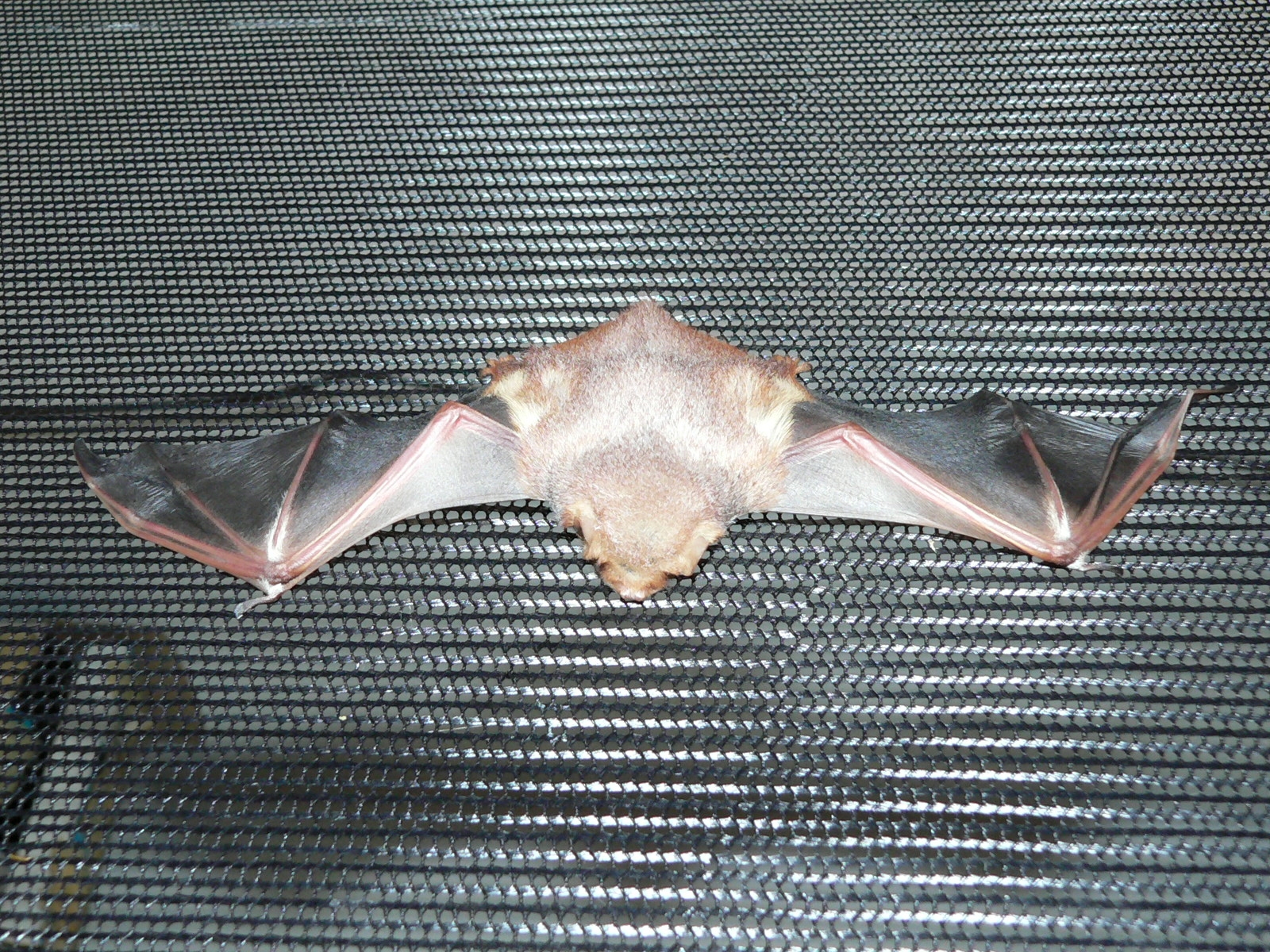
by Carrie Stevenson | Nov 4, 2013
As we leave Halloween season, one of the most popular images of this spooky time of year is that of a bat. The creepy tales of vampire bats and Dracula are enduring and certainly exciting. Unfortunately, many negative connotations exist around this fascinating species. Perhaps you’ve heard they carry rabies, that they will fly into your hair, or that many of them are considered blood-sucking vampire bats? In fact, there are many benefits to having bats in one’s landscape and neighborhood. The predominant role of bats in our local ecosystem is that of insect predator. A single little brown bat (Myotis lucifugis), which is native to the Florida Panhandle, can eat 1,200 mosquitoes in one hour of feeding! Many species eat moths that would otherwise cause destruction to agricultural crops and home vegetable gardens. Other species in warmer climates eat fruit and play a major role in re-foresting rain forests in Central and South America—after digesting the fruit they leave seeds in their droppings (guano is excellent fertilizer, by the way), helping replant 95% of the very trees they feed upon. Some species feed on nectar, filling the same role as bees and helping pollinate bananas, avocados, cashews, and figs.
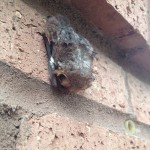
A young bat roosts along the bricks of a UWF campus building last summer.
Contrary to popular belief, bats are not blind and many have excellent vision. However, they do rely heavily on echolocation to sense prey and are extremely accurate hunters. They often fly erratically because they are chasing very small flying insects, so the only reason one would end up in a person’s hair is if a mosquito flew through it with a bat in chase! While vampire bats do exist, of more than 1,200 species of bats in the world there are only 3 that feed on blood, and they all live in Latin America. They also tend to feed on the blood of livestock. Human contact with bats is rare unless the bats are sick, which is why one found on the ground should be left alone. Rabies transmission from bats accounts for only one death per year in the United States—a statistic much less than that of deaths from dog bites, bee stings, and lighting strikes! In fact, several towns in Texas with the highest populations of bats in the country have recorded zero human bat-transmitted rabies cases.
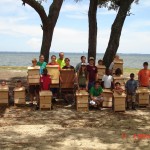
These 4-H campers built bat houses to provide shelter for bats in their neighborhoods
Bat populations are declining in North America due to disease (particularly white-nose syndrome), loss of habitat, and the slow reproductive cycle of bats. However, you can help the world’s only flying mammal by installing a bat house in your yard. Keep in mind that bats attracted to bat houses prefer to be in open areas away from trees (where their predators hide), and the house should be installed at least 12 feet in the air. Bat houses can be purchased or built rather simply—keep an eye out for Extension workshops near you, or check out the publication “Effective Bat Houses for Florida” online. In addition, Bat Conservation International’s website has a wealth of information on conservation projects worldwide.
by Alex Bolques | Sep 23, 2013
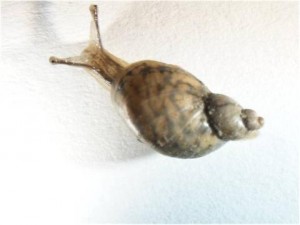
Cone Shaped or Cone Shell Snail Photo Credits: Heather M. Young, Biological Scientist, NFREC-Quincy
Occasionally on shipments of container plants, snails (terrestrial air-breathing gastropods) may be found attached to the container pot. Snails are abundant in nearly all parts of the world except the arctic regions, and feed almost entirely on vegetation. Those mostly encountered on nursery container plants are cone shaped reaching 1/2 to 2 1/2 inches in length and having an external enclosing spiral shell or occasionally rounded shell with four to five rapidly expanding whorls that are 1 to 1 1/4 inches in size.
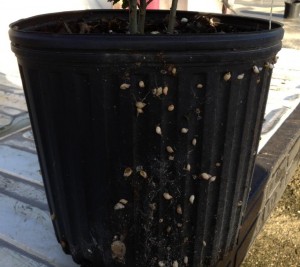
Image Credit: Henry Grant, Gadsden County Extension.
There are many species of snails. Most snails found on shipments are those restricted to tropical and semitropical regions requiring high humidity and warm temperatures. The U.S. has four native genera of Bulimulidae: Rhabdotus, Drymaeus, Orthalicus and Liguus. Of these, the last three genera are native to Florida. There is also another introduced genus in Florida, Bulimulus, which is primarily terrestrial. Other introduced species are Zachrysia provisoria and Caracolus marginellus in the Family Camaenidae occurs in Florida and found throughout much of the tropics.
Snails are also found in moist, shaded locations, which are similar to conditions found in container plant production areas, weedy locations or in organic trash. Most lay eggs throughout the season. Overwintering eggs may hatch in spring.
The following are general snail management suggestions:
- Remove excess organic material under plants. Organic materials provide moist hiding places for eggs and smaller snails, and sometimes as food sources.
- Monitor plant and environment moisture to reduce favorable snail habitats.
- When possible, remove the snails by hand, which is a reasonable, effective, nontoxic and environmentally acceptable control option.
- Check with your favorite garden store outlet for bait, biological, or chemical product control options.
For more information check out this gardening in a minute segment on snails and slugs.















